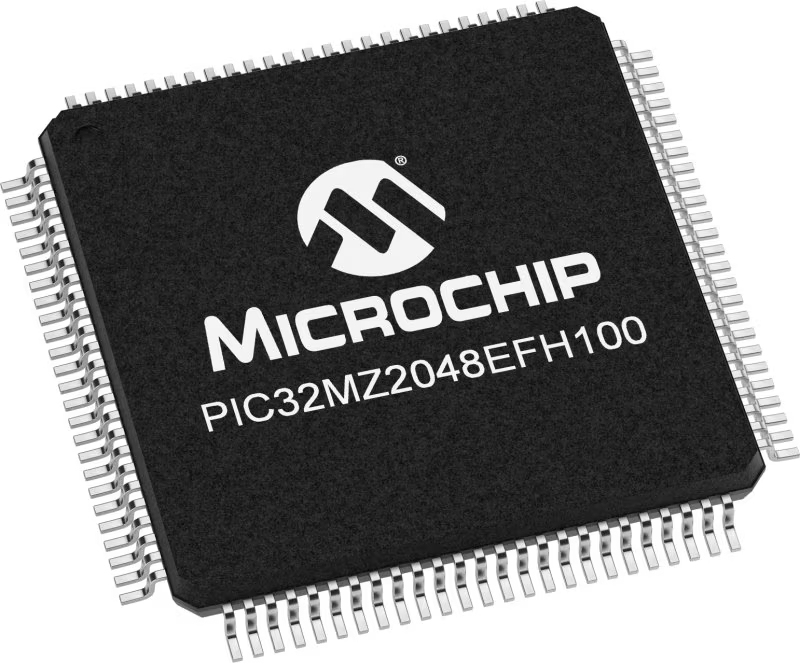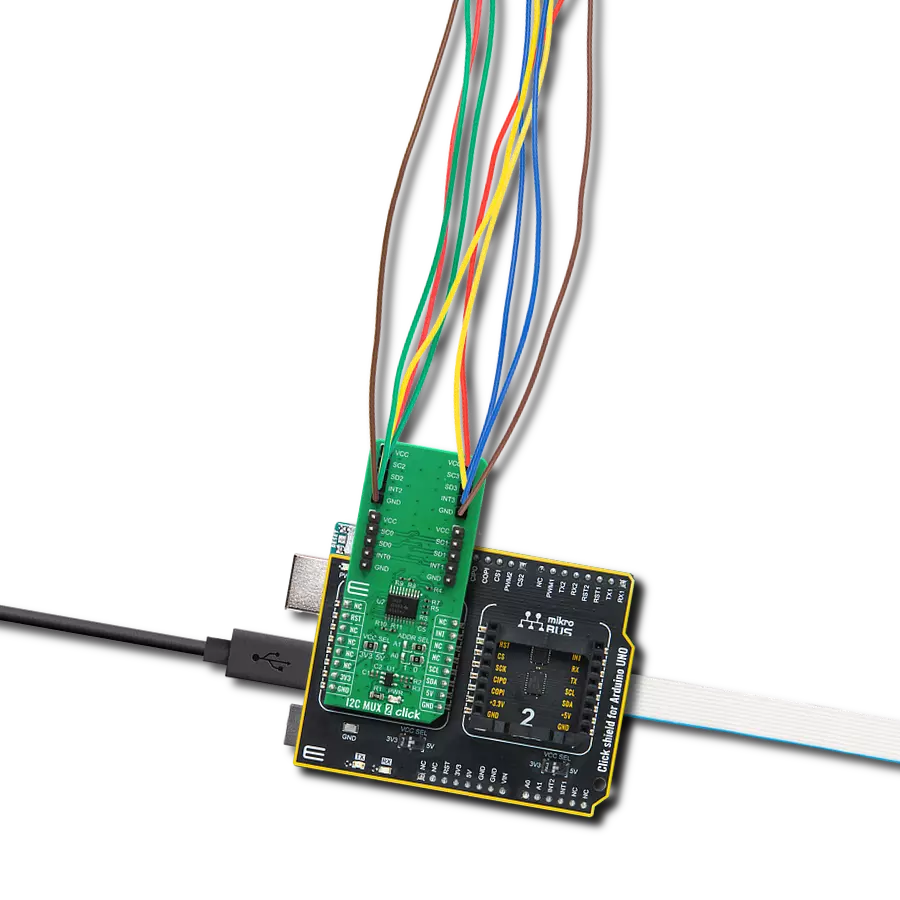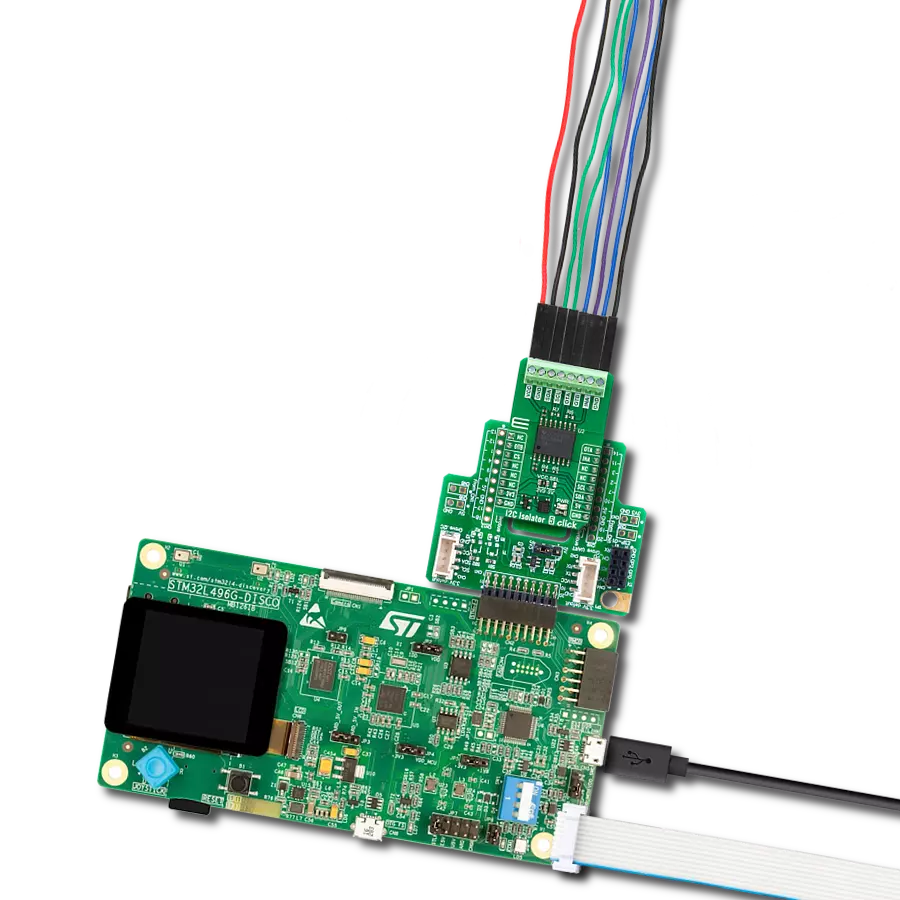Transform your projects with interface precision, as our bridge technology allows you to bridge the gap between I2C and SPI, optimizing data exchange, reducing complexity, and enhancing compatibility within your electronic applications
A
A
Hardware Overview
How does it work?
I2C to SPI Click is based on two SC18IS602B, an I2C-bus to SPI bridge from NXP Semiconductor. This IC bridges the data communication between the two interfaces, offering many additional features, such as the programmable I/O, internal oscillator option, active low interrupt output, low power mode, and more. The SC18IS602B operates as an I2C-bus slave-transmitter or slave-receiver and an SPI master. The SC18IS602B controls all the SPI bus-specific sequences, protocol, and timing. It also has its own internal oscillator, and it supports SPI chip select output that may be configured as GPIO when not used. This allows the software to be easily written or ported from another platform. The I2C to SPI Click provides a byte-oriented I2C-bus interface that supports data transfers up to 400 kHz. When the I2C-bus master is reading data from the click board™, the device will be a slave-transmitter. It also can be a slave-receiver when the I2C-bus master is sending data. The SC18IS602B acts as an I2C-bus master at no time. However, it does have the ability to hold the SCL
line LOW between bytes to complete its internal processes. A slave address of the SC18IS602B is comprised of a fixed and a programmable part. The programmable part of the slave address enables the maximum possible number of such devices to be connected to the I2C-bus. Since the SC18IS602B has three programmable address bits (defined by the A2, A1, and A0 pins), it is possible to have eight of these devices on the same bus. Therefore, this Click board™ is equipped with three SMD jumpers, grouped under the ADDR SEL label, used to select the I2C slave address. By moving the jumpers at the desired position, the user can select the address used for the communication with the host MCU. The #RESET pin performs the hardware reset of the SC18IS602B IC. The #RESET pin is routed to the mikroBUS™ RST pin and it is active LOW. The #INT allows the host MCU to receive an interrupt from the SC18IS602B IC. An interrupt is generated by the SC18IS602B after any SPI transmission has been completed. Therefore, the #INT of the
SC18IS602B is routed to the INT pin of the mikroBUS™ socket. The interrupt can be cleared (INT pin HIGH) by sending a ‘Clear Interrupt’ command, although It is not necessary. This allows more optimized software (firmware) to be written, as the host MCU does not have to continuously poll the LSR register to see if any interrupt needs to be serviced. The datasheet of the SC18IS602B offers more information about using and configuring the SC18IS602B IC. However, the Click board™ is supported by a mikroSDK library, offering functions that simplify the prototyping and firmware development. This Click board™ can be operated only with a 3.3V logic voltage level. The board must perform appropriate logic voltage level conversion before using MCUs with different logic levels. Also, it comes equipped with a library containing functions and an example code that can be used as a reference for further development.
Features overview
Development board
Flip&Click PIC32MZ is a compact development board designed as a complete solution that brings the flexibility of add-on Click boards™ to your favorite microcontroller, making it a perfect starter kit for implementing your ideas. It comes with an onboard 32-bit PIC32MZ microcontroller, the PIC32MZ2048EFH100 from Microchip, four mikroBUS™ sockets for Click board™ connectivity, two USB connectors, LED indicators, buttons, debugger/programmer connectors, and two headers compatible with Arduino-UNO pinout. Thanks to innovative manufacturing technology,
it allows you to build gadgets with unique functionalities and features quickly. Each part of the Flip&Click PIC32MZ development kit contains the components necessary for the most efficient operation of the same board. In addition, there is the possibility of choosing the Flip&Click PIC32MZ programming method, using the chipKIT bootloader (Arduino-style development environment) or our USB HID bootloader using mikroC, mikroBasic, and mikroPascal for PIC32. This kit includes a clean and regulated power supply block through the USB Type-C (USB-C) connector. All communication
methods that mikroBUS™ itself supports are on this board, including the well-established mikroBUS™ socket, user-configurable buttons, and LED indicators. Flip&Click PIC32MZ development kit allows you to create a new application in minutes. Natively supported by Mikroe software tools, it covers many aspects of prototyping thanks to a considerable number of different Click boards™ (over a thousand boards), the number of which is growing every day.
Microcontroller Overview
MCU Card / MCU

Architecture
PIC32
MCU Memory (KB)
2048
Silicon Vendor
Microchip
Pin count
100
RAM (Bytes)
524288
Used MCU Pins
mikroBUS™ mapper
Take a closer look
Click board™ Schematic

Step by step
Project assembly
Track your results in real time
Application Output
1. Application Output - In Debug mode, the 'Application Output' window enables real-time data monitoring, offering direct insight into execution results. Ensure proper data display by configuring the environment correctly using the provided tutorial.

2. UART Terminal - Use the UART Terminal to monitor data transmission via a USB to UART converter, allowing direct communication between the Click board™ and your development system. Configure the baud rate and other serial settings according to your project's requirements to ensure proper functionality. For step-by-step setup instructions, refer to the provided tutorial.

3. Plot Output - The Plot feature offers a powerful way to visualize real-time sensor data, enabling trend analysis, debugging, and comparison of multiple data points. To set it up correctly, follow the provided tutorial, which includes a step-by-step example of using the Plot feature to display Click board™ readings. To use the Plot feature in your code, use the function: plot(*insert_graph_name*, variable_name);. This is a general format, and it is up to the user to replace 'insert_graph_name' with the actual graph name and 'variable_name' with the parameter to be displayed.

Software Support
Library Description
This library contains API for I2C to SPI Click driver.
Key functions:
i2ctospi_spi_write_byte- Function SPI write the byte of data to the targeted 8-bit register address of the SC18IS602B I2C-bus to SPI bridge on the I2C to SPI Clicki2ctospi_spi_read_byte- Function SPI read the byte of data from the targeted 8-bit register address of the SC18IS602B I2C-bus to SPI bridge on the I2C to SPI Clicki2ctospi_clear_interrupt- Function clear interrupt is generated by the SC18IS602B after any SPI transmission has been completed
Open Source
Code example
The complete application code and a ready-to-use project are available through the NECTO Studio Package Manager for direct installation in the NECTO Studio. The application code can also be found on the MIKROE GitHub account.
/*!
* \file
* \brief I2cToSpi Click example
*
* # Description
* I2C to SPi Click allows serving as an interface between a standard I2C-bus of a microcontroller
* and an SPi bus, which allows the microcontroller to communicate directly with SPi devices
* through its I2C-bus. By offering an I2C-bus slave-transmitter or slave-receiver and SPI master,
* this Click controls all the SPi bus-specific sequences, protocol, and timing. It also has its own
* internal oscillator, and it supports the SPi chip select output that may be configured as GPIO when not used.
*
* The demo application is composed of two sections :
*
* ## Application Init
* Initialization driver enable's - I2C,
* hardware reset, SS0 ( CS ) configured to be used as slave select outputs, set the configuration of SPI:
* order MSB first, clock Idle low, leading-edge transition, SPI clock rate to 115kHz,
* set SPI EEPROM write enable SS0, clear interrupt,
* clear RT5 register, sets starting time: hours, minutes and seconds ( enable counting ), also write log.
*
* ## Application Task
* This is an example which demonstrates the use of RTC 5 Click is wired to I2C to SPI Click board.
* I2C to SPI Click communicates with register via the I2C interface,
* serve as an interface between a standard I2C-bus of a microcontroller and an SPI bus.
* RTC 5 Click communicates with register via SPI interface.
* In this examples, we display RTC time which we received reading from the target register
* address of MCP79510 chip on RTC 5 Click board via I2C interface of I2C to SPI Click board.
* Results are being sent to the Usart Terminal where you can track their changes.
* All data logs write on usb uart changes for every 1 sec.
*
* *note:*
* <pre>
* Additional Functions :
* - void display_log_uart( uint8_t value ) - Write the value of time or date as a two-digit number.
* - void rtc5_clear( i2ctospi_t *ctx, i2ctospi_spi_t *spi ) - Clear RTCC and SRAM memory of RTC 5 Click.
* - void rtc5_set_time_seconds( i2ctospi_t *ctx, i2ctospi_spi_t *spi, uint8_t seconds ) - Set the seconds and enable counting.
* - uint8_t rtc5_get_time_seconds( i2ctospi_t *ctx, i2ctospi_spi_t *spi ) - Get the seconds.
* - void rtc5_set_time_minutes( uint8_t minutes ) - Set the minutes.
* - uint8_t rtc5_get_time_minutes( i2ctospi_t *ctx, i2ctospi_spi_t *spi ) - Get the minutes.
* - void rtc5_set_time_hours( i2ctospi_t *ctx, i2ctospi_spi_t *spi, uint8_t hours ) - Set the hours.
* - uint8_t rtc5_get_time_hours( i2ctospi_t *ctx, i2ctospi_spi_t *spi ) - Get the hours.
* </pre>
*
* \author MikroE Team
*
*/
// ------------------------------------------------------------------- INCLUDES
#include "board.h"
#include "log.h"
#include "i2ctospi.h"
// ------------------------------------------------------------------ VARIABLES
static i2ctospi_t i2ctospi;
static i2ctospi_spi_t i2ctospi_spi;
static i2ctospi_gpio_t i2ctospi_gpio;
static log_t logger;
static uint8_t time_hours;
static uint8_t time_minutes;
static uint8_t time_seconds;
static uint8_t time_seconds_new = 0xFF;
// ------------------------------------------------------- ADDITIONAL FUNCTIONS
void display_log_uart ( uint8_t value )
{
log_printf( &logger, " %d%d ", ( uint16_t )( value / 10 ), ( uint16_t )( value % 10 ) );
}
void rtc5_clear ( i2ctospi_t *ctx, i2ctospi_spi_t *spi )
{
uint8_t reg_add;
spi->slave_device = I2CTOSPI_SLAVEDEVICE_SS0;
spi->function_id = I2CTOSPI_RTC5_COMMAND_WRITE;
spi->reg_addr = reg_add;
for ( reg_add = 0; reg_add < 0x20; reg_add++ )
{
i2ctospi_spi_write_byte( ctx, spi, 0x00 );
Delay_1us( );
}
spi->reg_addr = I2CTOSPI_RTC5_COMMAND_CLEAR;
i2ctospi_spi_write_byte( ctx, spi, 0x00 );
i2ctospi_clear_interrupt( ctx );
}
void rtc5_set_time_seconds ( i2ctospi_t *ctx, i2ctospi_spi_t *spi, uint8_t seconds )
{
uint8_t ones;
uint8_t tens;
uint8_t temp;
ones = 0x00;
tens = 0x00;
seconds %= 60;
ones = seconds % 10;
tens = ( seconds / 10 ) << 4;
temp = tens | ones;
temp |= I2CTOSPI_RTC5_COMMAND_ENABLE_COUNTING;
spi->slave_device = I2CTOSPI_SLAVEDEVICE_SS0;
spi->function_id = I2CTOSPI_RTC5_COMMAND_WRITE;
spi->reg_addr = I2CTOSPI_RTC5_REG_TIME_SEC;
i2ctospi_spi_write_byte( ctx, spi, temp );
}
uint8_t rtc5_get_time_seconds ( i2ctospi_t *ctx, i2ctospi_spi_t *spi )
{
uint8_t ones;
uint8_t tens;
uint8_t result_sec;
uint8_t temp;
spi->slave_device = I2CTOSPI_SLAVEDEVICE_SS0;
spi->function_id = I2CTOSPI_RTC5_COMMAND_READ;
spi->reg_addr = I2CTOSPI_RTC5_REG_TIME_SEC;
temp = i2ctospi_spi_read_byte( ctx, spi );
ones = temp & 0x0F;
tens = ( temp & 0x70 ) >> 4;
result_sec = ( 10 * tens ) + ones;
return result_sec;
}
void rtc5_set_time_minutes ( i2ctospi_t *ctx, i2ctospi_spi_t *spi, uint8_t minutes )
{
uint8_t ones;
uint8_t tens;
uint8_t temp;
ones = 0x00;
tens = 0x00;
minutes %= 60;
ones = minutes % 10;
tens = ( minutes / 10 ) << 4;
temp = tens | ones;
spi->slave_device = I2CTOSPI_SLAVEDEVICE_SS0;
spi->function_id = I2CTOSPI_RTC5_COMMAND_WRITE;
spi->reg_addr = I2CTOSPI_RTC5_REG_TIME_MIN;
i2ctospi_spi_write_byte( ctx, spi, temp );
}
uint8_t rtc5_get_time_minutes ( i2ctospi_t *ctx, i2ctospi_spi_t *spi )
{
uint8_t ones;
uint8_t tens;
uint8_t result_min;
uint8_t temp;
spi->slave_device = I2CTOSPI_SLAVEDEVICE_SS0;
spi->function_id = I2CTOSPI_RTC5_COMMAND_READ;
spi->reg_addr = I2CTOSPI_RTC5_REG_TIME_MIN;
temp = i2ctospi_spi_read_byte( ctx, spi );
ones = temp & 0x0F;
tens = ( temp & 0x70 ) >> 4;
result_min = ( 10 * tens ) + ones;
return result_min;
}
void rtc5_set_time_hours ( i2ctospi_t *ctx, i2ctospi_spi_t *spi, uint8_t hours )
{
uint8_t ones;
uint8_t tens;
uint8_t temp;
ones = 0x00;
tens = 0x00;
hours %= 24;
ones = hours % 10;
tens = ( hours / 10 ) << 4;
temp = tens | ones;
spi->slave_device = I2CTOSPI_SLAVEDEVICE_SS0;
spi->function_id = I2CTOSPI_RTC5_COMMAND_WRITE;
spi->reg_addr = I2CTOSPI_RTC5_REG_TIME_HOUR,
i2ctospi_spi_write_byte( ctx, spi, temp );
}
uint8_t rtc5_get_time_hours ( i2ctospi_t *ctx, i2ctospi_spi_t *spi )
{
uint8_t ones;
uint8_t tens;
uint8_t result_hours;
uint8_t temp;
spi->slave_device = I2CTOSPI_SLAVEDEVICE_SS0;
spi->function_id = I2CTOSPI_RTC5_COMMAND_READ;
spi->reg_addr = I2CTOSPI_RTC5_REG_TIME_HOUR;
temp = i2ctospi_spi_read_byte( ctx, spi );
ones = temp & 0x0F;
tens = ( temp & 0x30 ) >> 4;
result_hours = ( 10 * tens ) + ones;
return result_hours;
}
// ------------------------------------------------------ APPLICATION FUNCTIONS
void application_init ( void )
{
log_cfg_t log_cfg;
i2ctospi_cfg_t cfg;
/**
* Logger initialization.
* Default baud rate: 115200
* Default log level: LOG_LEVEL_DEBUG
* @note If USB_UART_RX and USB_UART_TX
* are defined as HAL_PIN_NC, you will
* need to define them manually for log to work.
* See @b LOG_MAP_USB_UART macro definition for detailed explanation.
*/
LOG_MAP_USB_UART( log_cfg );
log_init( &logger, &log_cfg );
log_info( &logger, "---- Application Init ----" );
// Click initialization.
i2ctospi_cfg_setup( &cfg );
I2CTOSPI_MAP_MIKROBUS( cfg, MIKROBUS_1 );
i2ctospi_init( &i2ctospi, &cfg );
i2ctospi_default_cfg( &i2ctospi );
//Set Time : 23h 59m 48s
rtc5_clear( &i2ctospi, &i2ctospi_spi );
rtc5_set_time_hours( &i2ctospi, &i2ctospi_spi, 23 );
Delay_1ms( );
rtc5_set_time_minutes( &i2ctospi, &i2ctospi_spi, 59 );
Delay_1ms( );
rtc5_set_time_seconds( &i2ctospi, &i2ctospi_spi, 48 );
Delay_1ms( );
}
void application_task ( void )
{
time_seconds = rtc5_get_time_seconds( &i2ctospi, &i2ctospi_spi );
Delay_1ms( );
time_minutes = rtc5_get_time_minutes( &i2ctospi, &i2ctospi_spi );
Delay_1ms( );
time_hours = rtc5_get_time_hours( &i2ctospi, &i2ctospi_spi );
Delay_1ms( );
if ( time_seconds_new != time_seconds )
{
log_printf( &logger, " Time : " );
display_log_uart( time_hours );
log_printf( &logger, ":" );
display_log_uart( time_minutes );
log_printf( &logger, ":" );
display_log_uart( time_seconds );
log_printf( &logger, "\r\n" );
log_printf( &logger, "------------------\r\n" );
time_seconds_new = time_seconds;
}
Delay_1ms( );
}
int main ( void )
{
/* Do not remove this line or clock might not be set correctly. */
#ifdef PREINIT_SUPPORTED
preinit();
#endif
application_init( );
for ( ; ; )
{
application_task( );
}
return 0;
}
// ------------------------------------------------------------------------ END

































